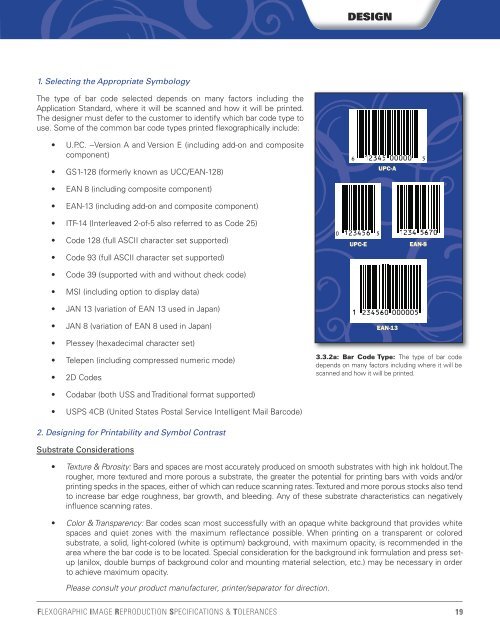First Design Guide - Flexographic Technical Association
First Design Guide - Flexographic Technical Association
First Design Guide - Flexographic Technical Association
Create successful ePaper yourself
Turn your PDF publications into a flip-book with our unique Google optimized e-Paper software.
1. Selecting the Appropriate Symbology<br />
The type of bar code selected depends on many factors including the<br />
Application Standard, where it will be scanned and how it will be printed.<br />
The designer must defer to the customer to identify which bar code type to<br />
use. Some of the common bar code types printed flexographically include:<br />
U.P.C. --Version A and Version E (including add-on and composite<br />
component)<br />
GS1-128 (formerly known as UCC/EAN-128)<br />
EAN 8 (including composite component)<br />
EAN-13 (including add-on and composite component)<br />
ITF-14 (Interleaved 2-of-5 also referred to as Code 25)<br />
Code 128 (full ASCII character set supported)<br />
Code 93 (full ASCII character set supported)<br />
Code 39 (supported with and without check code)<br />
MSI (including option to display data)<br />
JAN 13 (variation of EAN 13 used in Japan)<br />
JAN 8 (variation of EAN 8 used in Japan)<br />
Plessey (hexadecimal character set)<br />
Telepen (including compressed numeric mode)<br />
2D Codes<br />
Codabar (both USS and Traditional format supported)<br />
USPS 4CB (United States Postal Service Intelligent Mail Barcode)<br />
2. <strong>Design</strong>ing for Printability and Symbol Contrast<br />
Substrate Considerations<br />
Texture & Porosity: Bars and spaces are most accurately produced on smooth substrates with high ink holdout. The<br />
rougher, more textured and more porous a substrate, the greater the potential for printing bars with voids and/or<br />
printing specks in the spaces, either of which can reduce scanning rates. Textured and more porous stocks also tend<br />
to increase bar edge roughness, bar growth, and bleeding. Any of these substrate characteristics can negatively<br />
influence scanning rates.<br />
Color & Transparency: Bar codes scan most successfully with an opaque white background that provides white<br />
spaces and quiet zones with the maximum reflectance possible. When printing on a transparent or colored<br />
substrate, a solid, light-colored (white is optimum) background, with maximum opacity, is recommended in the<br />
area where the bar code is to be located. Special consideration for the background ink formulation and press setup<br />
(anilox, double bumps of background color and mounting material selection, etc.) may be necessary in order<br />
to achieve maximum opacity.<br />
Please consult your product manufacturer, printer/separator for direction.<br />
FLEXOGRAPHIC IMAGE REPRODUCTION SPECIFICATIONS & TOLERANCES<br />
DESIGN<br />
UPC-A<br />
UPC-E EAN-8<br />
EAN-13<br />
3.3.2a: Bar Code Type: The type of bar code<br />
depends on many factors including where it will be<br />
scanned and how it will be printed.<br />
19


